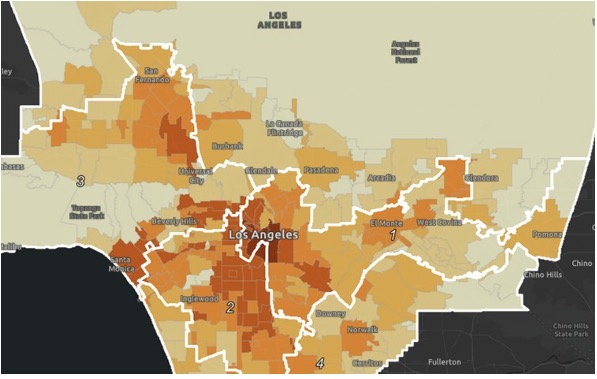Comments
PLANNING WATCH - If you still believe that the worsening housing crisis is caused by a housing shortage, and that it can be solved by gutting zoning laws so real estate speculators have a free hand, you should look at LA’s Hollywood neighborhood for a reality check. In Hollywood the rampant construction of new, high-rent, high-rise apartment buildings has totally discredited these planning policies. They have increased housing costs and traffic congestion, forced residents into homelessness, demolished low-priced housing, reduced population and transit ridership, and taxed old infrastructure. Quite a list of trickle-down accomplishments!
The panacea of zoning deregulation, in Hollywood’s case parcel-level entitlements that City Hall reflexively grants to developers, has led to flipping and the construction of expensive apartment towers with high vacancy rates. The imagined benefits of trickle-down planning policies, advanced by ambitious academics, LA Times editorialists and guest columnists, and major city planning departments, has been disproven in Hollywood.
A perfect example is Richard Glaeser’s and Atta Turki’s op-ed in the 02/19/2023 LA Times, “Reforms haven’t created enough housing. Here’s what would.” A few of their dubious claims, followed by my debunking, follow:
Claim: LA’s housing shortage drives prices upward. No, housing prices relentlessly rise in LA because corporate speculators pay cash for houses and apartments. This is their business model for generating quick profits since LA renters now shell out $40 billion per year to keep a roof over their head. Furthermore, LA’s housing shortage only applies to low-priced housing, not market rate and luxury housing, which have much higher vacancy rates.
Claim: LA must incentivize private developers to bring down housing costs. No, Los Angeles has endless miles of commercial corridors already zoned for large apartments. Plus, developers can easily evade existing zoning laws through Transit Oriented Community (TOC) incentives. Nevertheless, developers still shun these parcels, despite these permissive zoning laws and easily discarded height, density, and parking requirements.
Claim: California Senate Bill 9, which allows single-family lot splits and twin duplexes, has flopped because it does not allow enough housing. No, Senate Bill 9 predictably failed because few homeowners want to demolish their own house, move to a rental for several years, subdivide their lot, and then build and operate two duplexes. This business model is designed for mansionizers, but they make much more profit with much less hassle by building and selling a single McMansion.
Claim: California in general, and Los Angeles in particular, “needs to allow developers to bypass zoning codes and land-use laws as long as more than a fifth of the units or a project are affordable to lower-income families.” This solution combines mandatory inclusionary zoning with the total elimination of zoning. After this miracle is completed in a city, Los Angeles, which has consistently rejected inclusionary zoning, the next hurdle is enforcement. It barely exists in Los Angeles. No City employee ever inspects a TOC or Section 8 voucher apartment to confirm that its rents are affordable and that its tenants are low-income. In effect, LA’s lack of enforcement has already deregulated zoning, and the results are spiraling homelessness, population loss, and soaring rents. This is day-to-day reality in Hollywood and similar neighborhoods.

Los Angeles County homeless map. Deregulation is a cause, not a solution.
Furthermore, in addition to the above shortcomings, Glaeser’s and Tarik’s solution of relying on large housing construction companies to build their way out of the housing crisis is riddled with other problems. While the zoning deregulation the authors praise already permeates LA’s 2021-2029 Housing Element and the Hollywood and Downtown Community Plan Updates languishing in the City Council’s in-box, the authors have ignored three critical questions:
- Where would large, corporate-built housing subdivisions be located? Los Angeles is a totally built out older city, and Porter Ranch, dating back to 2002, was LA’s last undeveloped open space. This is why new housing in Los Angeles is located at infill sites, which require developers to push or buy out existing residents before bulldozing their houses or small apartment buildings.
- What about upgrading infrastructure and public services to serve the new building and residents? At present, Los Angeles, especially in the older neighborhoods, like Hollywood, targeted by developers, has failing infrastructure and public services. Furthermore, L. A. has no monitoring programs, up-to-date infrastructure and public services plans, or capital budgets to upgrade a neighborhood’s infrastructure and services so it can meet the needs of new buildings and residents.
- Who will rent these new apartments? New housing is expensive, and LA – unlike Glendale and other nearby cities -- does not have an inclusionary housing ordinance. In LA new apartment buildings have no legal obligation to include low-priced units. Furthermore, LA has lost 200,000 people since 2021, and wages for most Angelenos are stagnant, made worse by inflation. Few people have escaped the housing crisis, and those who can afford to live in new, infill houses and apartments are a tiny fraction of the population.
If Glaeser, Turki, and their local disciples, truly want to reduce homelessness, they should stop shilling for big developers and start calling for funded programs that:
- Preserve existing low-priced housing.
- Strengthen rent control.
- Index wages to the cost of housing.
- Restore terminated HUD and CRA public housing programs.
- Prevent real estate speculators from buying up houses and apartments.
The ball is in their court.
(Dick Platkin is a retired Los Angeles city planner who reports on local planning issues for CityWatchLA. He serves on the board of United Neighborhoods for Los Angeles (UN4LA). Previous Planning Watch columns are available at the CityWatchLA archives. Please send questions and corrections to rhplatkin@gmail.com.) Top Photo: Chronicle/Brant Ward
















